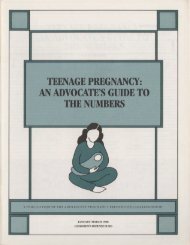child care - Digital Library Collections
child care - Digital Library Collections
child care - Digital Library Collections
Create successful ePaper yourself
Turn your PDF publications into a flip-book with our unique Google optimized e-Paper software.
CHAPTER<br />
CHILD HEALTH<br />
dequate health <strong>care</strong> is essential for every<br />
<strong>child</strong>. Without it, <strong>child</strong>ren may suffer enormously,<br />
losing the chance for a healthy start<br />
in life and a productive future. Untreated<br />
medical conditions often worsen over time<br />
and can lead to permanent disabilities. In some<br />
cases, lack of medical <strong>care</strong> may cost <strong>child</strong>ren their<br />
very lives. Poor health can also jeopardize <strong>child</strong>ren's<br />
ability to succeed in school and in later jobs.<br />
Yet more than II million American <strong>child</strong>ren<br />
lack health insurance today, and the percentage of<br />
<strong>child</strong>ren without health coverage has risen in recent<br />
years to the highest levels ever recorded by the<br />
u.s. Census Bureau. The vast majority of uninsured<br />
<strong>child</strong>ren, more than 90 percent, have parents<br />
who work. However, as more and more employers<br />
have made dependent health coverage more costly<br />
for employees or dropped it altogether, fewer families<br />
can afford private insurance. In the past year,<br />
extraordinary strides were made in expanding <strong>child</strong>ren's<br />
health insurance coverage through landmark<br />
legislation that may help up to 5 million<br />
uninsured <strong>child</strong>ren. Intensive efforts are required<br />
in all 50 states for <strong>child</strong>ren to benefit fully from this<br />
new law. States now have an unprecedented opportunity<br />
to make high-quality, affordable health <strong>care</strong><br />
more widely available to uninsured <strong>child</strong>ren and to<br />
dramatically improve the health of millions.<br />
Child Health: 1973 to 1998<br />
Child health has improved in important ways<br />
over the past 25 years. For example, infant<br />
mortality and preventable <strong>child</strong>hood illnesses<br />
have declined substantially. Change has also swept<br />
the country's health <strong>care</strong> system, profoundly affecting<br />
access to health <strong>care</strong> for <strong>child</strong>ren. Notably, a<br />
nationwide shift to managed <strong>care</strong> delivery systems<br />
has altered the way many <strong>child</strong>ren receive health<br />
services. In addition, two dramatic and contradictory<br />
trends have emerged: a steep decline in employment-based<br />
coverage for <strong>child</strong>ren and significant<br />
increases in the number of <strong>child</strong>ren covered<br />
by Medicaid (health insurance coverage for lowincome<br />
<strong>child</strong>ren and families, for elderly individuals,<br />
and for people with disabilities).<br />
According to two different federal surveys, private<br />
coverage ofAmerican <strong>child</strong>ren (most ofwhich<br />
is employment-related) dropped more than 7 percent<br />
between 1977 and 1987 and another 7 percent<br />
from 1987 to 1996. Meanwhile, the number of<br />
<strong>child</strong>ren covered by Medicaid rose from between 9<br />
CHI L D R EN'S D E FEN S E FUN D 21














